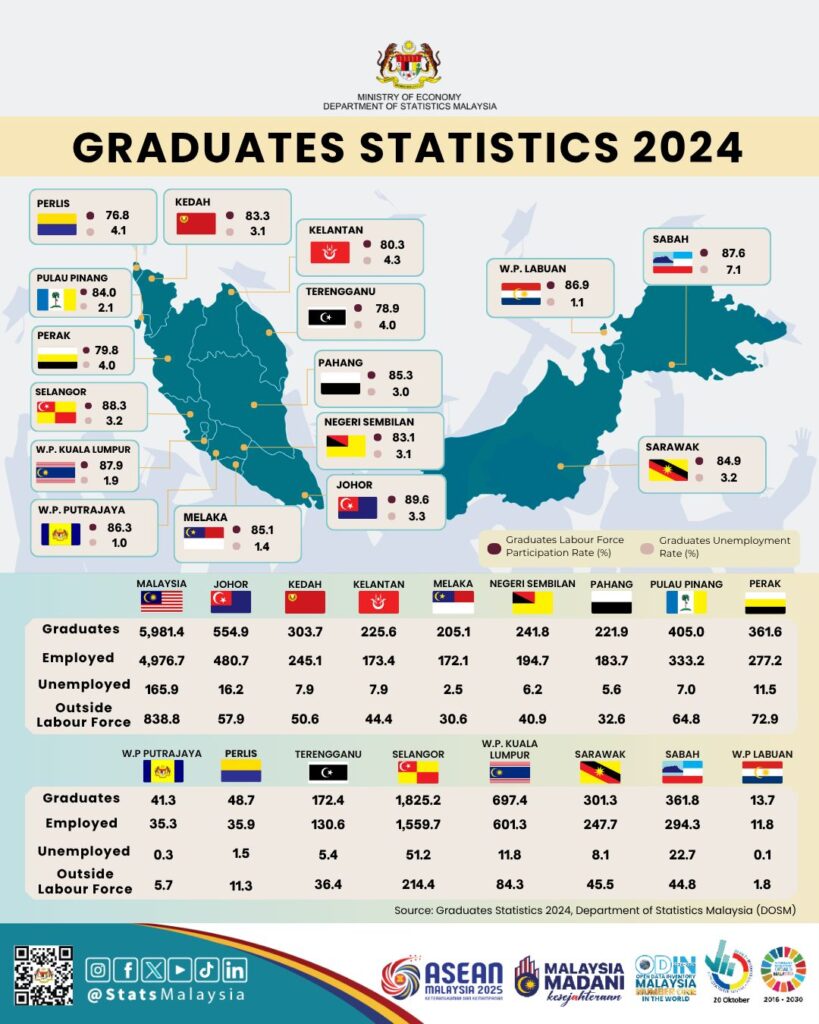
Graphic and data courtesy of DOSM FB
PUTRAJAYA, Nov 2: Graduate salaries in Malaysia continued to rise in 2024, according to the 2024 Graduates Statistics released by the Department of Statistics Malaysia (DOSM).
The median monthly salary and wage increased 2.5 per cent to RM4,521 (2023: RM4,409) while the mean salary rose by 8.1 per cent to RM5,330 (2023: RM4,933),
For the record, the median is the middle value when all salaries are arranged in order. Half of graduates earn less than RM4,521, and half earn more.
As for the mean (or average), it is calculated by adding all salaries together and dividing by the number of graduates.
All states in the country recorded positive growth in both median and mean monthly graduate salaries in 2024 compared to the previous year. The three locations with the highest median graduate salaries were Kuala Lumpur (RM5,888), followed by Putrajaya (RM5,723) and Selangor (RM5,207).
As for graduate unemployment, the rate declined by 0.2 percentage points to 3.2 per cent compared to 3.4 per cent in the previous year, said Chief Statistician Datuk Seri Dr Mohd Uzir Mahidin.
Consequently, the number of unemployed graduates decreased by 0.8 per cent to 165,900 in 2024, from 167,300 in 2023, he said.
A more positive trend was observed among active job-seeking graduates, with 61.1 per cent securing employment within three months, said Dr Mod Uzir.
The number of graduates in Malaysia increased to 5.98 million in 2024, with the unemployment rate declining to 3.2 per cent, in line with the strong growth of the labour market.
Dr Mohd Uzir said the positive economic and labour market environment throughout 2024 contributed to an increase in the number of graduates, accounting for 22.3 per cent of the working-age population aged 15 years and above.
“Of this total, 5.14 million were active in the labour force, resulting in a high Graduate Labour Force Participation Rate (GLFPR) of 86.0 per cent.
“Degree holders accounted for 54.9 per cent (3.28 million persons), while diploma holders represented 45.1 per cent (2.70 million persons).
“Year-on-year, the number of degree graduates in the labour force rose by 5.4 per cent, while diploma holders increased by 3.2 per cent, driven by better job opportunities and lower unemployment rates,” he said.
Dr Mohd Uzir said in 2024, the number of employed graduates grew by 4.6 per cent to 4.98 million compared to 4.76 million in 2023, in tandem with Malaysia’s improving labour market.
About two-thirds, or 67.8 per cent, of employed graduates were in the skilled category, amounting to 3.38 million persons, with most working as professionals (57.2 per cent), followed by technicians and associate professionals (24.4 per cent) and managers (18.4 per cent).
“Graduates in the semi-skilled category made up 31.0 per cent (1.54 million persons), while those in the low-skilled category accounted for only 1.2 per cent (57,500 persons).
“Employment among skilled and semi-skilled graduates each recorded positive growth of 5.0 per cent and 3.6 per cent respectively, while the low-skilled category increased by 11.0 per cent,” he said.
In terms of employment status among graduates, Mohd Uzir said employees formed the largest share at 86.4 per cent, totalling 4.30 million persons in 2024, an increase of 3.5 per cent year-on-year.
The employer category, representing 5.6 per cent, rose significantly by 10.4 per cent to 277,600 persons. Similarly, the number of self-employed graduates, constituting 7.2 per cent of employed graduates, increased by 16.0 per cent to 360,500 persons in 2024.
Unpaid family workers accounted for the remaining 0.8 per cent, with 37,900 persons recorded,” he said.
By economic sector, Dr Mohd Uzir said the majority of employed graduates were in the services sector, comprising 77.6 per cent or 3.86 million persons, followed by the manufacturing sector (13.4 per cent; 667,300 persons) and the construction sector (6.3 per cent; 313,100 persons).
The agriculture and mining and quarrying sectors accounted for 1.7 per cent (83,900 persons) and 1.0 per cent (49,200 persons), respectively.
Dr Mohd Uzir said in 2024, the number of graduates employed below their qualifications increased by 3.9 per cent to 1.60 million persons, bringing the graduate skill-related underemployment rate down to 32.2 per cent.
“This achievement places Malaysia ahead of countries such as South Korea (36.8 per cent), Indonesia (42.2 per cent), and the Philippines (56.7 per cent), demonstrating efforts to reduce skill mismatch.
“Although Malaysia still trails advanced economies such as the United Kingdom (28.5 per cent), the United States (27.3 per cent), and Australia (27.5 per cent), the downward trend indicated potential for further improvement in the coming years,” he said.
Dr Mohd Uzir added that although the national Female Labour Force Participation Rate (LFPR) stood at 56.2 per cent in 2024, the Female Graduate Labour Force Participation Rate (GLFPR) was significantly higher at 83.4 per cent.
- BERNAMA